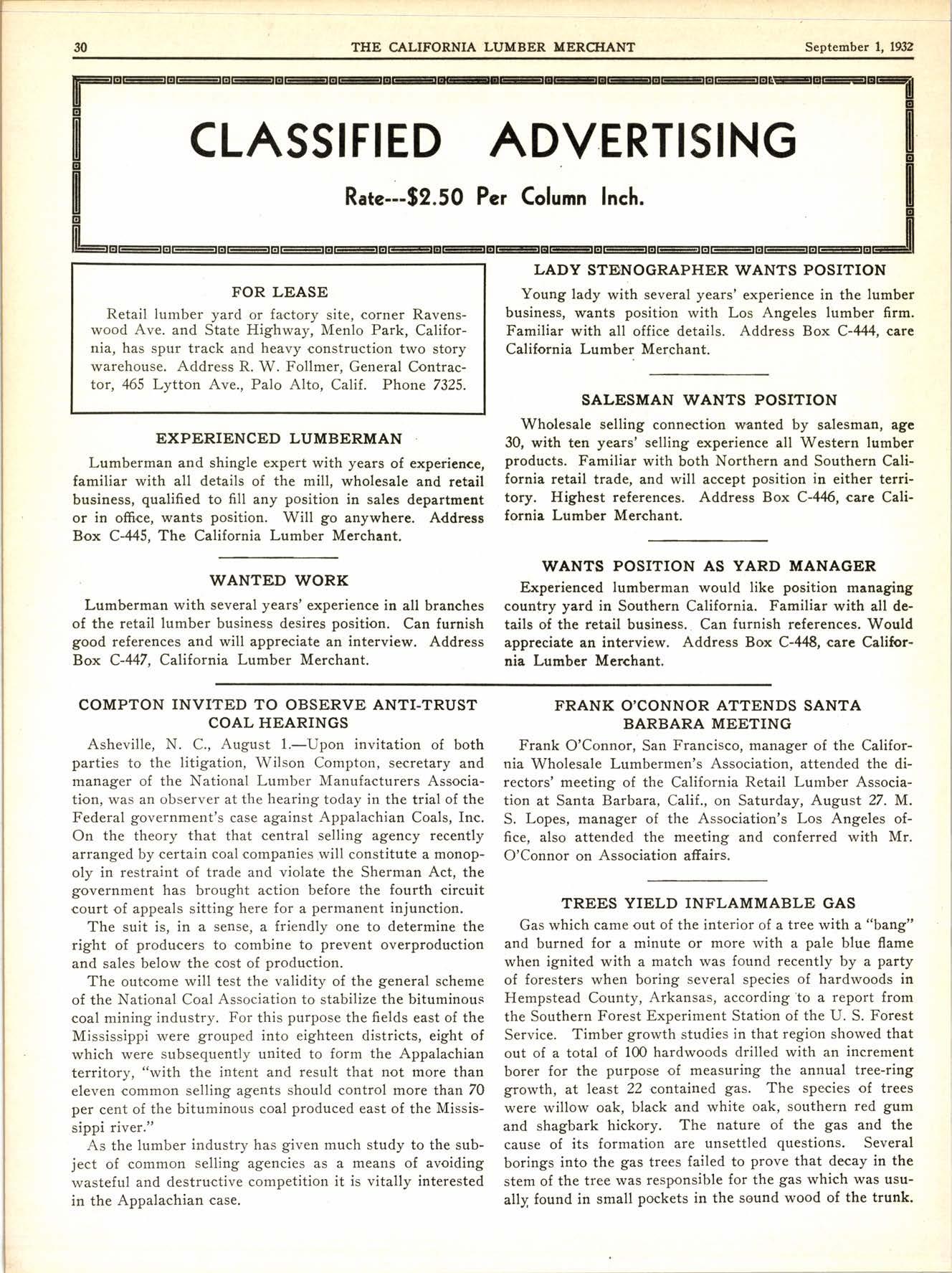
3 minute read
I PROGRAM PROBLEMS
(Continued f.rom Page 24)
Adopted By Itestern Pine Association
Upon Recommendation U "t";lll3;r Committec a-Sawmill production control-present method unstable-temporary. b-Timber control-fundamental-long time. l. Readjust tax burden-see 4 below.
2. Sustained yield forest management, which automatically limits annual cut to capacity of forest units to produce continuously, a-Pro4uct inrproved to meet competition bV (l) identification by species, grade and trade marking, (2) strict conformance to grade standards, (3) grade name revisior4 (4) proper seasoning with reasonable dryness standards as soon as practicable, (5) lumber inspection system co-ordinated by inter-regional conferences, (6) meeting consumer requtrements. b-Improved marheting nethode, including (1) concentration of sales by mergor., sales agencies, elimination multiple representation in given market, (2) larger expendi- tures to improve results, (3) observance code lumber trade practice, with improve- ment of code, car cards, etc. c-Treda promotion, including rclelrch, to meet competition. General tax reduction to encourage home building and farm construction; home financing. Development new products, new uses old products, etc. a-Adjurt hours worL per week to produce to balance with market demand while employing full normal personnel b-Minimum wagc rtandardr. c-As safety valve-long time government planaing and budgeting, with central control of public construction. d-Sustained yield forest management to improve and stabilize labor conditions. a-Secure generat tax.reduction through government economy, eliminatingiunnecessary governmental activities and machinery, increasing efficiency, adjusting salaries and wages to changing conditions. b-General tax reform to distribute burden equitably-especially relieve real estate by transferring burden largely to other forms of taxation. c-Timber land tax reform-substitute yield tax. a--4eneral reduction lumber ratcr accordance present W. C. L. A. and W. P. A. b-Indreare r:ailroad net income and so reducc all rates bv: l. Removal of U. S, as competitor, direct or indirect. c-Secure equitable rates on lumber compared other commodities. a-By increasing or decreasing existing protection secure balancc of expected bencfitr. co3t against b-q. S. pay 50Vo, state 25Vo and owner 25Vo tor protection private forest land. c-Promote sustained yield forest managem€nt, automatically improving protection.
(a) Apply to all publicly owned or controlled forest land.
(b) Apply to private forest land so far as practicable. Increase practicability by (l) mergers, (2) economic selective logging, (3) timber tax reform, (4) improved protection, and especially (5) management of public timber in cooperation with private for this purpose.
(c) Extend public ownership of forest land by exchange, purchase, holding tax title land, etc. Do this with main purpose of bringing all forest land under sustained yield management (l) directly in public ownership, or (2) in private ownership assisted to such management as indicated in b-2-(b)-(5) above.
2. Public regulation of competing transport facilities.
3. Repeal portions of law imposing unreasonable economic burdens.
4. Reduction of taxes on railroads (a) by general reduction and (b) by equitable shift of taxation-especially to competitors.
7 UNFAVORABLE a-To meet sound criticism: PUBLIC ATTI- l. Sustained yield forest management. TUDE TOWARD
2. Economic selective logging, protecting residual stands. LUMBER b-To meet unjustified criticism, educate public as to facts.
Machinery to rtudy, aolvc, and efrectively apply rolutionr to problems of mutual interest:
3. MACHINERY c c c
Letters beloui indicate several kinds machinery defined at bottom or page.
A-Lumber induetry coopcration-present system _which includes : (a) western pine industry cooperation through W. P. A.; (b) sales managers conferences-sectional, regional, national; (c) cooperation W. P. A. witti 4L; with Pacific Division-National Box, with W. C. L. A., with N. L. M. A., etc.
B-Intcr-economic Group Cooperation-, would include coopcration of organized unitr of lumber induetry (companies, regional associations, N. L. M. A., etc.) with similar units of other economic groupr such as railroads, banks, farming, mining, etc.
C-Public cooperation-incl_udqs cooperation ol_ olelnized t'lits -of lumber industry with organized units representing public, such as counties, states, IJ. S. Forest Service, U. S. Indian Service, U. S. Timber Conservation Board, etc.
To promote effective operation of above machinery this program urges: l. Modification anti-trust laws permitting (under appropriate federal supervision) atreements to regulate production; and
2. Legislation authorizing (under appropriate federal supervision) indurtrial eelf-government, whereby an appropriate part of any -given industry (or logical sub-division thereof) may adopt rules of practice binding upon the entiie industry (or sub-division).
August, 1932
%urenathreebd room home ur'tlt asmaller arnount ofvuare fubqe tlzan rs u,a,ia,//v taheizup n a ftre rodm house- 'J/ee more you studv the e/easfrq exterrdr and compdct rcom-arranqehent the ar@t- er wrV be your desire tobut/d dhome fuom tltis ideal plan €-b











